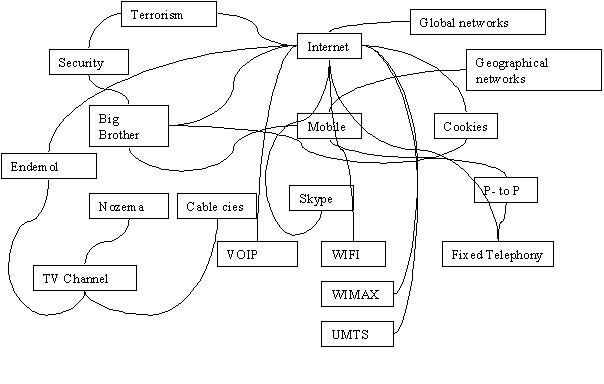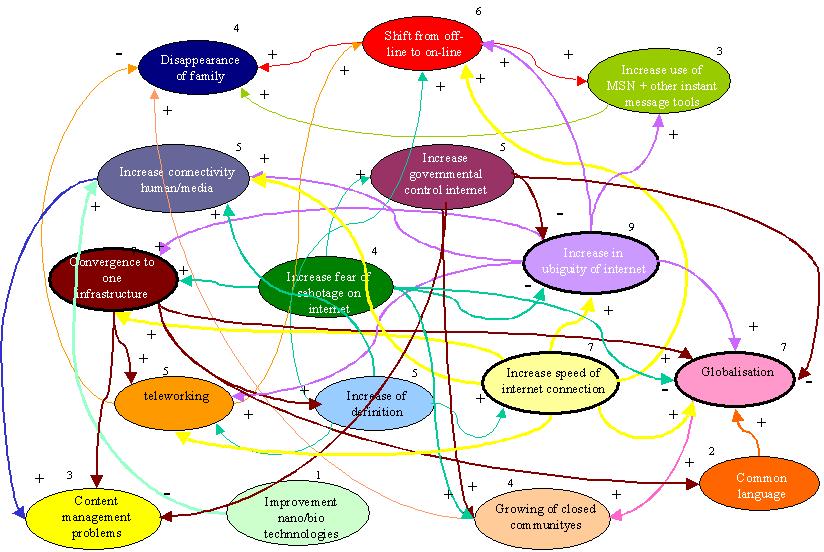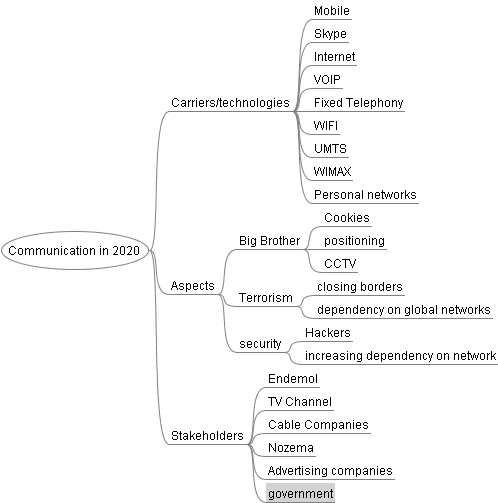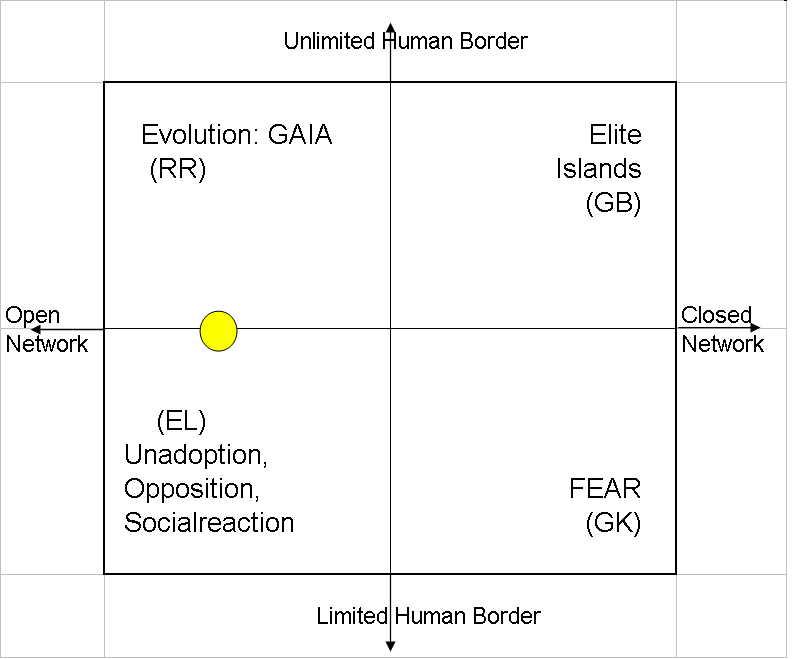The future of communication in 2015
Introduction
This page will contain the results of the scenario planning process of group 5 of class RSM EMBA05 on the following subject:
The future of communication in 2015
The idea behind this proposed scenario originates from the intensifying battle unfolding in The Netherlands between the incumbent telephony provider, KPN and the cable operator, UPC. Both companies enjoy a monopoly in their core product offerings – that is to say telephony, in the case of KPN and TV/Video, in the case of UPC – and were originally content to restrict their efforts solely to such offerings. Gradually, however, rapid technological advancements enabled both companies to compete across multiple products - TV/Video, the Internet and telephony (fixed and mobile). A recent development was UPC’s attack on KPN’s fixed line telephony business through VoIP (voice over IP). This was the first step in the rapid convergence of all technologies to the IP network. KPN have responded through an attack on UPC’s core product by investing heavily in TV/Video over the Internet (IPTV). How will the battle between the companies now develop?
The key to being able to answer this question is the drawing of a considered conclusion on how the communications industry – and in this we include the entertainment business also - will develop over the medium term – say the next 10 years.
Research questions
Research question - communication 2015
Driving Forces
Increasing Fear of Sabotage on internet (RR)
Increasing Fear of Sabotage on internet
Increase the connectivity between human and media (GB)
Increase the connectivity between human and media
Convergence of all media to IP network (GK)
Convergence of all media to IP network
Increase Governamental Control on the Internet (RR)
Governmental Control of the Internet
The Increase in the speed of internet connection (GB)
The Increase in the speed of internet connection
The Increase in ubiquity of the internet (GK)
The Increase in ubiquity of the internet
Increase in teleworking (JP)
Globalization (RR)
Improvement Nano/Biotechnology (EL)
Improvement Nano/Biotechnology
Growing of closed community (JP)
Increased used of MSN and other instant messaging tools (JP)
Increased used of MSN and other instant messaging tools
Disappearance of "family" (RR)
Increasing content management problems as result of new technologies(JP)
Increasing content management problems as result of new technologies
=Technology=
- level of convergence of all technologies to the IP network (Jeroen)
- development of new technologies (Graham)
- security (RR)
- creation of unique identifiers and convergence of identifiers/numbers (Giuseppe)
- diffusion of Wireless (mobile) access (Wi-Fi/Wi-Max) to the Internet (Giuseppe)
=Strategy=
- Commoditization of technology and impact of low/no cost wireless connection (Erik)
- Appropriation of value (e.g. voip for skype)(Jeroen)
- Role of television channels: who will own the broadcasting (Graham)
- New role of advertisement (Giuseppe)
=Society=
- Influence of telecommunication on mobility, work habits, lifestyle and on interaction among individuals (Erik)
- Level of access to entertainment (Graham)
- Is technology the driver or is demand the driver (Jeroen)
- Privacy and separation of work from personal life (Rolando)
Research Documentation
Pause or Play? The Future of Interactive Services for TV Accenture white paper
Path to Profitability: How Cable Companies can Achieve Attractive Returns on iTV Servicesanother Accenture white paper
Freeband Communication is a Dutch national research program aiming to create a leading knowledge position for the Netherlands in the area of ambient, intelligent communication. Link to Freeband
Personal Networking Pilot 2008
link to: PNP 2008
Systems diagram
As a result of the first brainstorm the next concept system diagram is made:

A lot of thinking and new insights made it necessary to start again with the systems diagram. Basis of this new diagram are the driving forces, the enablers and inhibitors.

=he following "mindmap" is also a help c.q. a start to determine all the aspects related to communication in the future. Please send your comments and/or additions to the creator.

Key Uncertainties
Scenario on Communication in 2015
== Opposition,
Unadoption,
Social reaction
scenario ==
Open network, limited human borders.
2010: The increasing availability of networks with high quality and high speed has changed our lives and will change our lives more and more. This availability means that it is very cheap and everyone is indeed connected all the time. Living on-line is becoming reality very fast. Gaining information is very easy and also entertainment through internet is coming into our lives in various kinds. Communication between people will increase whether by phone, by mail, by chatting, by SMS and various other kinds. Where should this end ? Until what level can we handle this ? Is this the life we want? These questions will become more and more important.
2010 – 2015: The broad awareness that this “living” does not satisfy all our needs in communication is increasing. And although the quality of information and “virtual realities” is increasing very fast, it is still artificial. It is not as real as to speak and communicate with people directly. As we know ninety percent of communication goes through non-verbal communication and by “body language”. People are becoming aware that living on-line does not enrich their lives and they are rejecting this artificial living more and more. They are going to stick more and more to the former ways of communicating, meeting each other in public events, restaurants, pubs etc. Social live as it used to be becomes more popular.
The rejection of this artificial way of living is also a movement and a need to find rest again in our lives. With the availability of open networks, the amount of information we have to deal with, is overwhelming. Live speeds up and we won’t get any rest in our daily lives. The appreciation of the quality of live will increase strongly. This involves other kinds of communication and other kinds of living than the “on-line life”. The readiness to adapt all the possibilities is halted because our understanding of life refuses to change. Maybe humanity is not ready for this way of living yet.
Economical impact The economical impact can be compared to the burst of the internet bubble. Huge amounts of capital invested in new technologies are loosing their value. A global recession will be unavoidable. The hunger for new technologies is aleviated which means that the driving force for our global economy is fading away. Since the movement of rejection new technologies will first appear in the western world the economical power in the world will shift to developing countries. The large differences between rich and poor countries will decrease.
Political impact The globalisation will slow down and together with that the political issues will become more local than global. The political power in the world will not be concentrated on the superpowers in the world like the G8 of 2005. Political power will be normalised again.
Technological impact
The technological evolution is slowed down because the driving force- the hunger for technological improvement- has aleviated. The rejection to technology is strongly linked to the ethical issues related to biotechnology, nanotechnology and other technologies to change all kind of life in our biosphyre. All this possibilities are not longer wanted.
Social impact Quality of life is becoming more important. This also means a “social” life as it used to be. Society will change drasticaly. The speed of life will slow down or at least be halted. Social contacts between people will increase which enrich our lifes and hapiness on a other way than the financial drive did before.
Ecological Directly linked with technological improvement are two movements: - Energy consumption will increase because of a higher demand caused by “welfare” in the years before 2005. This will cause a more polluted environment. If technological improvement slows down and quality of life in an other way will become more important the increasing demand of energy will slow down. - Energy production can become more and more environmental friendly because of technological improvements. Solar, wind and hydrogen energy production needs constant technological improvements. If this will be slowed down the environment will become more polluted.

